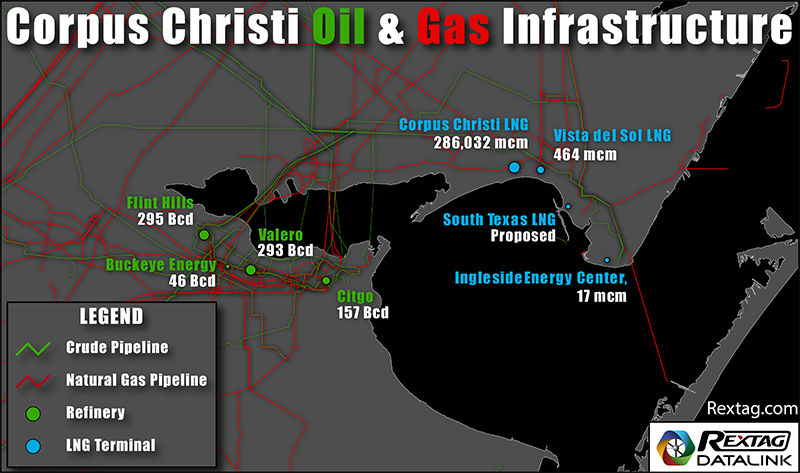Comprehensive Energy Data Intelligence
Information About Energy Companies, Their Assets, Market Deals, Industry Documents and More...
Corpus Christi and its O&G Infrastructure
06/07/2017
Permian’s Midstream Takeaway. Are we in for a problem any time soon? Who are the regional industry champions? Read some facts below. Today looking at Corpus Christi. See key facilities on a map above.
As the threat of too much oil and too few pipelines in the Permian Basin continues to loom, midstream developers are trying to keep up with the aggressive pace of producers with some looking toward growing export opportunities on the Texas Gulf Coast.
Magellan is one of several companies looking to lay a new pipeline from the Permian to Corpus Christi, Texas, and also is currently expanding its BridgeTex Pipeline in the basin.
Why the Permian? If you look at the analysis that shows breakeven economics based on where to spend the money, producers that have acreage in the Permian are getting the most profits.
The rig count in the Permian Basin has more than doubled since 2016 with 361 active rigs in the basin as of May 19 vs. 137 a year ago, according to Baker Hughes Inc. (NYSE: BHI).
At the same time, the Energy Information Administration is also projecting an increase of crude oil production in the Permian Basin to an estimated 2.4 million bbl/d in May. The Permian produced about 2 million barrels per day (bbl/d) of crude oil in May 2016.
However, midstream developers are already addressing the projected constraint with announced midstream projects in the Permian so far during second-quarter 2017 significantly exceeding activity in the rest of the U.S., according to a May 23 report by Stratas Advisors.
So far, Permian midstream developers have announced 23 new projects, expansions or completions at expanding pipelines, terminals and docks, tanks and processing plants during the second quarter compared to the 20 projects elsewhere, the report said.
Through its Longhorn and BridgeTex pipeline systems, Magellan currently has takeaway capacity of roughly 575,000 bbl/d, which is expected to increase by 100,000 bbl/d in a month or so following completion of its BridgeTex expansion project.
“Through the process of doing all that we’ve identified some ways to increase the capacity even further,” he said. “We’re very confident we’ll get to 450,000 and we may even be able to get above 450,000 with fairly limited work that needs to be done.”
Barnes said the new pipeline Magellan is developing to transport Permian crude to Corpus Christi will have multiple origin points, both in the Delaware and Midland basins, as well as multiple delivery points in the Corpus Christi area.
Indeed, Texas continues to rank as the U.S. leading natural gas producing state. As a reflection of that, gas transmission and processing activities mount. The complete landscape of the Lone Star State's natural gas industry can be found on Rextag's Texas Natural Gas Infrastructure Map.
If you are looking for more information about energy companies, their assets, and energy deals, please, contact our sales office mapping@hartenergy.com, Tel. 619-349-4970 or SCHEDULE A DEMO to learn how Rextag can help you leverage energy data for your business.
Delays Are Finally Over: Enbridge Reports Strong Third Quarter 2021
![$data['article']['post_image_alt']](https://images2.rextag.com/public/blog/Enbridge-Reports-Strong-Third-Quarter-2021.png)
Enbridge Inc. finally delivered on several of its long-overdue promises, including the $4 billion Line3 Replacement project. Which consisted of replacing an existing 34-inch pipe with a new 36-inch one for 13 miles in North Dakota, 337 miles in Minnesota, and 14 miles in Wisconsin. Midstream companies, in general, had a stunning Q3. It was the first quarter in two years that no midstream index members cut their dividends.
Pinnacle Midstream: Sierra Grande Gas Processing Plant Construction
![$data['article']['post_image_alt']](https://images2.rextag.com/public/HEMDS_SiteSupportFiles/BlogImages/Pinnacle_Map.png)
Pinnacle Midstream began construction on its Sierra Grande Gas Processing Plant. Will begin operation in 4Q of 2017.
![$data['article']['post_image_alt']](https://images2.rextag.com/public/blog/328_Blog_Why Are Oil Giants Backing Away from Green Energy Exxon Mobil, BP, Shell and more .jpg)
As world leaders gather at the COP29 climate summit, a surprising trend is emerging: some of the biggest oil companies are scaling back their renewable energy efforts. Why? The answer is simple—profits. Fossil fuels deliver higher returns than renewables, reshaping priorities across the energy industry.
![$data['article']['post_image_alt']](https://images2.rextag.com/public/blog/327_Blog_Oil Market Outlook A Year of Growth but Slower Than Before.jpg)
The global oil market is full of potential but also fraught with challenges. Demand and production are climbing to impressive levels, yet prices remain surprisingly low. What’s driving these mixed signals, and what role does the U.S. play?
![$data['article']['post_image_alt']](https://images2.rextag.com/public/blog/326_Blog_USA Estimated Annual Rail CO2 Emissions 2035.jpg)
Shell overturned a landmark court order demanding it cut emissions by nearly half. Is this a victory for Big Oil or just a delay in the climate accountability movement?